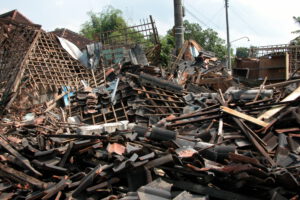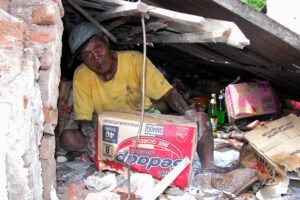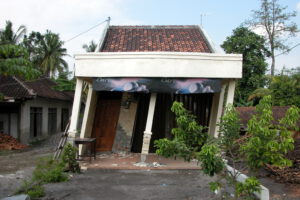Short Definiton of an Earthuake
An earthquake is a sudden and violent shaking of the ground caused by the movement of tectonic plates beneath the Earth’s surface. Earthquakes are triggered by the spontaneous release of stress in the Earth’s crust, leading to the release of energy in the form of seismic waves, which can cause significant damage to buildings, structures, and landscapes.
Earthquakes are one of the most frequent natural disasters and typically occur along continental plate boundaries or manifest at fault zones. Earthquakes can also be associated with volcanic activity.
During an earthquake, seismic waves propagate through the solid rock of the Earth’s crust. They can also penetrate the Earth’s mantle, but at a slower pace. One characteristic of waves is that their speed depends on the density of the medium they pass through. This property has provided valuable clues for geoscientists to understand the Earth’s shell structure.
Earthquake strength and magnitude
The strength of earthquakes is determined from the maximum amplitudes of seismograms and referred to as magnitude. There are different magnitude scales: the most common is the moment magnitude scale Mw. It starts at 0 and goes up to the value 10.5. At this value the solid earth crust would break completely. An increase of one magnitude releases 32 times the energy. Earthquakes from magnitude 3 can be felt by humans and damage to property occurs from Mw 5. Earthquakes stronger than Mw 6 are called strong earthquakes. Earthquakes stronger than Mw 7 are mostly catastrophic.
Decisive for the consequences of an earthquake is also its depth. If the hypocentre is less than 10 km deep, the damage is significantly greater than for earthquakes of comparable magnitude at greater depths. Strong earthquakes at depths of more than 25 km are relatively seldom catastrophic.
The effects of an earthquake are also related to its duration. While weak earthquakes last only a few seconds, very strong earthquakes can last up to 3 minutes. It is logical that long-term earthquakes can also cause major damage. In addition to the magnitude, depth and duration of the earthquake, other factors determine the consequences: its distance from settlements, the condition of the building fabric and the direction of oscillation of the earthquake waves.
The different earthquake waves
Basically 3 different seismic wave types are distinguished. P waves and S waves are generated directly by an earthquake. They propagate from the hypocenter spherically in all directions and are therefore also called space waves. These excite the so-called surface waves, which do not propagate spherically but are guided along the surface.
Frequency of severe earthquakes
As a natural phenomenon, there are countless earthquakes every day, but most of them are so weak that people are not aware of them. Earthquakes that cause damage occur almost daily worldwide. Earthquakes with a magnitude of 6 and higher occur several times a month. Earthquakes that kill people are not quite as common. You can get an overview of current earthquakes on websites with an earthquake monitor.
Earthquake prediction
The prediction of earthquakes has so far only been successful in a few cases. Unlike volcanic eruptions, the signs are very difficult to measure and interpret. As a rule, there are no concrete warnings or evacuation measures.
Often an unusual behaviour of animals was observed before an earthquake. In 1975, for example, snakes and frogs fled their homes from an earthquake in China. Birds and pets can also indicate an impending earthquake by their restless behaviour.
Today, modern metropolises are often earthquake-proof. It is important that even high-rise buildings can vibrate and thus transmit the energy of earthquake waves. This flexibility is not only achieved by modern building materials. The foundations are placed on hydraulic piers that compensate for part of the earthquake vibrations.
Rigid structures cannot withstand strong earthquakes.
Behaviour during earthquakes
If you are in a building during an earthquake and stays close to the exit, you should leave the building quickly. If this is not possible, it is often recommended to stand under a door frame or under a table. The latest recommendations of the disaster control are to lie flat on the floor next to solid pieces of furniture. Falling ceiling parts could be caught by the pieces of furniture and form a hollow space in which one could survive. The GFZ Potsdam has published a leaflet on earthquake precautions.
Current earthquakes with a magnitude 2,5 and bigger


